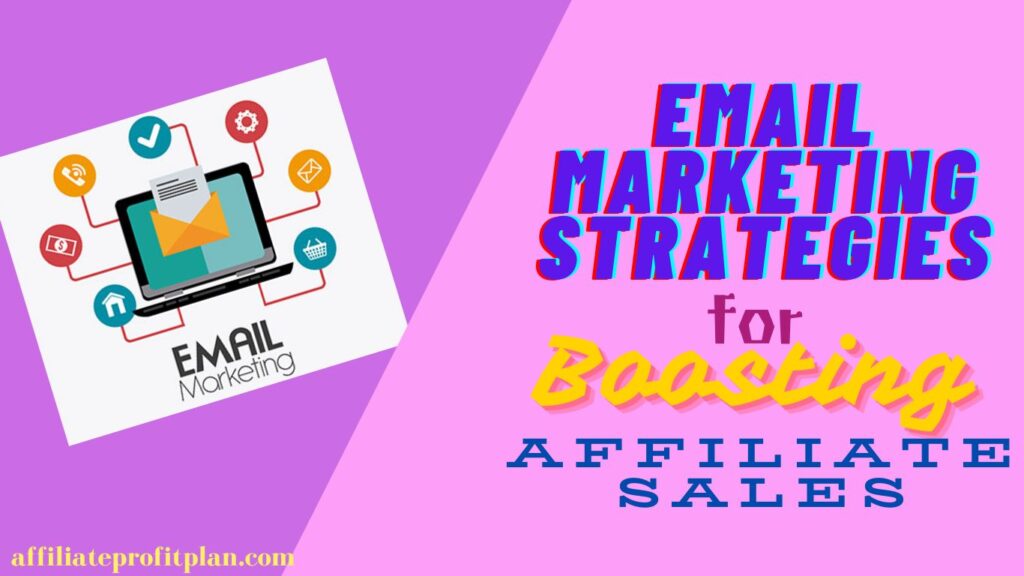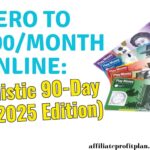Welcome to my article Email Marketing Strategies for Boosting Affiliate Sales. In the world of affiliate marketing, where every click and conversion counts, email marketing is like that dependable friend who always shows up to help you move—often underappreciated but crucial for getting the job done. With the potential to nurture relationships and drive sales, email marketing can significantly boost your affiliate income. If you’ve been relying solely on social media or SEO to get your affiliate products out there, it’s time to dust off that email list and put it to work!
In this article, we’ll explore some top-notch email marketing strategies specifically designed to boost your affiliate sales. Whether you’re just starting out or looking to refine your existing campaigns, these tips will help you turn that email list into a revenue-generating machine. So grab your favorite beverage, get comfortable, and let’s dive into the strategies that will have your affiliate sales soaring like a well-placed airplane banner!
Access My Proven Blueprint for $50-$100 Daily Income – Watch This FREE Video Now >>>

Build a Targeted Email List
Building a targeted email list is like planting a garden. You want to cultivate the right soil, select the best seeds, and nurture them into a flourishing landscape of engaged subscribers. After all, what good is a massive email list if it’s filled with folks who have the attention span of a goldfish? When it comes to boosting your affiliate sales, a targeted email list is your secret weapon—allowing you to reach the right people with the right message at the right time.
So, how do you get started? First things first: create lead magnets that your audience simply can’t resist. Think of lead magnets as the free samples at a grocery store. Who can say no to a delicious bite of cheese while they’re shopping for dinner? Similarly, offering a free eBook, checklist, or exclusive content can entice potential subscribers to hand over their email addresses. It’s essential to align your lead magnets with your niche. For instance, if you’re in the health and wellness space, a “7-Day Healthy Meal Plan” or “Top 10 Tips for Stress Relief” can draw in those eager to improve their well-being.
Next, don’t underestimate the power of social media! Promoting your email list on platforms like Instagram, Facebook, or TikTok can significantly boost your sign-up rates. Share eye-catching graphics that highlight the benefits of joining your list, or run contests and giveaways where entering requires an email subscription. Who wouldn’t want a chance to win a fabulous prize while also getting valuable content delivered to their inbox? It’s a win-win situation that brings new subscribers straight to your virtual doorstep.
Additionally, ensure your email sign-up process is as smooth as butter on hot toast. Optimize your website’s layout by placing sign-up forms in high-visibility areas—think pop-ups, footer sections, and dedicated landing pages. The goal is to make it as easy as possible for visitors to subscribe. A complicated sign-up process is like a traffic jam on a Monday morning—frustrating and likely to send people running in the opposite direction.
Lastly, leverage the power of partnerships and collaborations. Partner with other bloggers or influencers in your niche to tap into their audience. You could create joint webinars, guest blog posts, or co-host giveaways, all of which can lead to increased visibility and new subscribers. Just like sharing a pizza with friends makes for a more enjoyable experience, sharing audiences can amplify your reach and grow your email list.
Segment Your Email List for Better Targeting
Imagine walking into a bakery that only sells one kind of pastry: the classic croissant. Now, if you’re a die-hard fan of chocolate éclairs, you’d probably walk right back out—no éclair means no interest, and no sales for the bakery. Similarly, in the world of email marketing, sending the same generic message to your entire list is like offering every subscriber just croissants. To truly boost your affiliate sales, you need to segment your email list for better targeting. Think of segmentation as a way to serve up a delightful array of pastries, ensuring everyone finds something they love!
First off, let’s talk about why segmentation matters. When you segment your email list, you group your subscribers based on specific criteria such as demographics, behavior, or interests. This targeted approach allows you to tailor your messages, resulting in higher open rates, click-through rates, and ultimately, conversions. Studies show that segmented campaigns can lead to a staggering increase in revenue—proof that delivering the right message to the right people makes all the difference!
So, how do you go about segmenting your list? Start by collecting data at the point of subscription. When someone signs up for your email list, consider asking a few simple questions that help you understand their preferences. For instance, if you run a beauty blog, ask subscribers about their favorite products—skincare, makeup, or hair care. This way, you can tailor your content and affiliate promotions to match their interests. Just remember, keep it short and sweet; nobody wants to fill out a novel-length questionnaire!
Next, utilize behavioral data to inform your segmentation strategy. This involves tracking how subscribers interact with your emails and website. Are there specific products they click on frequently? Do they often engage with certain types of content? By analyzing this behavior, you can create segments based on interests, such as “frequent buyers,” “bargain hunters,” or “new subscribers.” This means when you promote affiliate products, you can send targeted messages that resonate with each group, ensuring they see offers that excite them—like a warm pastry fresh out of the oven!
Another effective segmentation strategy is to create different lists for different stages of the customer journey. For example, you might have one list for new subscribers who are just getting to know your brand and another for loyal customers ready to explore new affiliate offers. This allows you to tailor your messaging according to where subscribers are in their relationship with your brand. New subscribers might appreciate a welcome series that introduces them to your best content, while loyal customers may be more interested in exclusive deals or new product launches.
Don’t forget about seasonal or timely segmentation! If you notice a particular event or holiday approaching, consider creating segments based on that context. For instance, if you promote fitness products, you might want to segment your list for New Year’s resolutions or summer workout gear. Tailoring your content to align with these timely events can lead to higher engagement and conversions—like offering a special pastry flavor that’s only available for a limited time.
Lastly, regularly clean and update your email list. Not everyone will be a perfect fit for your segments, and that’s okay! Remove inactive subscribers who haven’t engaged in a while. This helps maintain a healthy email list and ensures that your campaigns are reaching engaged recipients who are genuinely interested in your content.
Craft Compelling Email Content
When it comes to email marketing, crafting compelling content is akin to being a skilled chef in a bustling restaurant—you need to whip up delicious dishes that keep your guests coming back for seconds. In the same vein, your email content must be enticing, informative, and actionable to engage your subscribers and drive those all-important affiliate sales. If your emails feel more like a soggy sandwich than a gourmet meal, it’s time to spice things up!
Access My Proven Blueprint for $50-$100 Daily Income – Watch This FREE Video Now >>>
Let’s start with the crown jewel of your email: the subject line. This little nugget holds the power to determine whether your email gets opened or sent straight to the dreaded spam folder. A catchy subject line is like the irresistible aroma of freshly baked cookies wafting through the air—it draws people in! Aim for a balance between intrigue and clarity. You want to pique curiosity while giving a hint of what’s inside. Try using numbers, asking questions, or creating a sense of urgency. For instance, “5 Secrets to Mastering Affiliate Marketing” or “Last Chance: Exclusive Offer Ends Tomorrow!” can entice subscribers to click.
Once your email is opened, it’s time to hook your readers with personalized greetings and engaging content. Addressing subscribers by name can create a sense of connection, making them feel valued and appreciated. This simple touch can set the tone for the rest of your email. Now, let’s talk about the body of your email. Keep it concise, relevant, and easy to read. Use short paragraphs, bullet points, and bold headings to break up text—nobody wants to face a daunting wall of words. Instead, present your information in bite-sized chunks that are easy to digest. Think of it as plating your dish artfully; it’s all about the presentation!
Now, onto the meat of your email: the actual content. Whether you’re promoting an affiliate product, sharing valuable tips, or telling a captivating story, ensure your content provides real value to your readers. After all, they’re not just looking for a sales pitch; they want insights, advice, and solutions to their problems. For example, if you’re promoting a kitchen gadget, you might include a brief recipe or cooking tips alongside the product. This not only showcases the product but also demonstrates how it can enhance your reader’s life—like adding the perfect seasoning to elevate a dish.
Don’t forget the call-to-action (CTA)! Your CTA is like the cherry on top of your sundae—it should be tempting and make your readers eager to take the next step. Whether it’s clicking a link, making a purchase, or signing up for a webinar, ensure your CTA stands out visually and is strategically placed within your email. Use action-oriented language like “Get Your Free Trial Now” or “Shop the Exclusive Offer” to encourage clicks. And remember, having multiple CTAs throughout your email can provide readers with various opportunities to engage—just don’t go overboard and overwhelm them like an overstuffed burrito!
Another key ingredient in crafting compelling email content is authenticity. Your subscribers want to hear from a real person, not a robotic marketing machine. Share your personal experiences, successes, and even your challenges. This transparency builds trust and relatability, encouraging readers to connect with you on a deeper level. When your audience feels they know you, they’ll be more likely to trust your recommendations and take action on your affiliate offers.
Finally, don’t forget to include social proof! Testimonials, reviews, or user-generated content can be powerful motivators for potential buyers. By showcasing how others have benefited from the products you promote, you reinforce your credibility and provide readers with the reassurance they need to make a purchase.
Utilize Automation for Timely Campaigns
In the fast-paced world of affiliate marketing, timely communication can be the difference between a sale and a missed opportunity. That’s where email automation comes in, acting like your trusty sous-chef, ready to handle the repetitive tasks that can weigh you down. By automating your email campaigns, you can focus on crafting those gourmet messages while ensuring that your audience receives timely, relevant content. Let’s dive into the delightful world of email automation and see how it can supercharge your affiliate marketing efforts!
First off, let’s discuss what email automation actually is. It’s the ability to send emails automatically based on specific triggers or schedules. Think of it like setting up a coffee machine to brew your favorite blend every morning at 7 AM. You wake up to the delicious aroma without having to lift a finger! Similarly, with email automation, you can set up a series of emails to go out at precise times, ensuring your subscribers receive valuable content exactly when they need it. This not only saves you time but also keeps your audience engaged and informed—like a perfectly timed dinner party where every course is served at just the right moment.
One of the most effective ways to utilize automation is through welcome email sequences. When someone signs up for your email list, they’re likely excited and eager to know what you’re all about. A warm and engaging welcome series sets the tone for your relationship. Consider sending a series of 2-3 emails that introduce your brand, share your best content, and offer exclusive affiliate deals. This way, new subscribers feel appreciated right from the start, and you lay the groundwork for a trusting relationship. Plus, a well-structured welcome sequence can lead to higher engagement rates, setting the stage for future conversions.
Another powerful application of email automation is the drip campaign. Think of drip campaigns as a slow-cooked meal: they take time, but the results are well worth it! This strategy involves sending a series of targeted emails over a specific period to nurture leads or guide subscribers toward a particular action. For instance, if you’re promoting a course or product, you could set up a drip campaign that shares valuable tips or insights related to the topic, gradually leading your audience toward the sale. This approach allows you to build anticipation and demonstrate the value of your offerings without overwhelming your subscribers with a hard sell right out of the gate.
Time-sensitive promotions or seasonal offers are another excellent opportunity for automation. If you’re running a limited-time affiliate deal or a holiday special, automated emails can ensure that your audience is informed and ready to act. By scheduling reminder emails in advance, you can keep your subscribers in the loop about the promotion without needing to send them manual updates. Think of it as a friendly nudge, reminding them that the clock is ticking on a fantastic opportunity. Just like that last call to grab dessert before it’s gone, timely reminders can create a sense of urgency that prompts your subscribers to take action.
Let’s not forget about re-engagement campaigns! Not every subscriber will stay active, but that doesn’t mean you should write them off completely. Automated re-engagement emails can help you reconnect with those who may have gone quiet. A simple “We Miss You!” email, combined with an enticing offer or a request for feedback, can rekindle interest and re-establish communication. After all, every relationship has its ups and downs, and sometimes a little attention is all it takes to get things back on track.
Lastly, automation isn’t just about sending emails—it’s also about monitoring and analyzing the results. Most email marketing platforms offer robust analytics that allows you to track open rates, click-through rates, and conversion rates. By keeping an eye on these metrics, you can continually optimize your automated campaigns for better performance. If you notice that certain emails are underperforming, don’t hesitate to tweak the subject lines, content, or send times. Think of it as fine-tuning your recipe until you achieve that perfect flavor balance.
Analyze and Optimize Your Email Campaigns
In the culinary world, even the best chefs know that cooking is as much about experimentation as it is about following recipes. The same principle applies to email marketing. Analyzing and optimizing your email campaigns is the secret sauce that transforms a good strategy into a great one. Just like adjusting the seasoning in your favorite dish, continual refinement based on data can make all the difference in how your emails perform. So, grab your digital spatula, and let’s dive into the delicious world of email campaign analysis!
First things first: what do we mean by analyzing email campaigns? It involves diving into the metrics your email marketing platform provides to understand how your subscribers are interacting with your content. Key metrics include open rates, click-through rates, conversion rates, bounce rates, and unsubscribe rates. These numbers are like your culinary thermometer, helping you gauge whether your dish is cooked to perfection or in need of a little more time in the oven.
Let’s start with open rates. A high open rate is like receiving rave reviews at a dinner party—everyone is eager to taste what you’ve prepared! To improve this metric, revisit your subject lines. Are they catchy enough? Do they evoke curiosity or urgency? Experiment with different styles and lengths. A/B testing is your best friend here! Test out two different subject lines to see which one garners a better response. With each tweak, you’ll inch closer to the perfect recipe for capturing your audience’s attention.
Next up is click-through rates (CTR). This metric tells you how many of your subscribers took the bait and clicked on the links in your email. A low CTR might suggest that while your subject line got them in the door, the content inside didn’t quite live up to their expectations. Consider analyzing the placement and wording of your calls to action (CTAs). Are they clear and compelling? A well-placed, action-oriented button can be the difference between a leisurely browse and an enthusiastic purchase. Don’t be afraid to experiment with different CTAs to see which ones resonate most with your audience.
Now, let’s discuss conversion rates—the ultimate goal of any email campaign. A high conversion rate is like serving up a perfectly cooked meal that leaves everyone satisfied. This metric shows you how many subscribers took the desired action, whether that’s making a purchase, signing up for a webinar, or downloading a resource. If your conversion rates aren’t where you want them to be, take a closer look at your overall email content. Are you providing enough value? Are you addressing your audience’s pain points? Sometimes, a small shift in how you present your affiliate products can lead to a significant increase in conversions.
Don’t forget to keep an eye on bounce rates, too. A high bounce rate is akin to guests leaving your dinner party early—nobody wants that! A bounce happens when your email fails to deliver to a subscriber’s inbox, either due to a full mailbox or an invalid email address. Regularly cleaning your email list is essential. Removing inactive subscribers and correcting typos in email addresses can help ensure that your emails are landing where they’re supposed to—right in the hearts (and inboxes) of your audience.
Unsubscribe rates are another critical metric to monitor. If you notice an uptick in unsubscribes, it’s time for some soul-searching. Take a look at the content you’re sending. Are you overwhelming your subscribers with too many promotions or not delivering enough value? A well-balanced email campaign should feel like a well-rounded meal, offering a mix of educational content, engaging stories, and promotional offers. Aim to create a delightful experience that leaves your audience wanting more, rather than a bland menu that sends them running for the exit.
Once you’ve analyzed your campaign data, it’s time to optimize! Optimization is about making informed adjustments based on the insights you’ve gathered. This could mean tweaking your email design, refining your audience segments, or even adjusting your send times. For example, if you find that your emails perform better in the evenings rather than mornings, consider shifting your send schedule accordingly. It’s all about finding that sweet spot where your subscribers are most receptive.
Lastly, remember that analyzing and optimizing your email campaigns is not a one-and-done task. The landscape of affiliate marketing is ever-changing, and so are your audience’s preferences. Make it a habit to review your metrics regularly, perhaps after each campaign or monthly, to stay on top of what’s working and what isn’t. This ongoing commitment to analysis will help you refine your strategy, allowing you to create more impactful campaigns over time.
Conclusion
As we reach the grand finale of our culinary journey through email marketing strategies for boosting affiliate sales, it’s time to take a moment to reflect on all the delectable insights we’ve gathered. Just like the perfect dish requires a balance of flavors, your email marketing efforts demand a blend of strategies that work harmoniously together to create an irresistible experience for your subscribers. By implementing the tactics we’ve discussed—from building a targeted email list to crafting compelling content, utilizing automation, analyzing performance, and optimizing your campaigns—you’re well on your way to whipping up a successful email marketing strategy that not only drives affiliate sales but also fosters lasting relationships with your audience.
Access My Proven Blueprint for $50-$100 Daily Income – Watch This FREE Video Now >>>
Remember, email marketing is not a one-size-fits-all endeavor; it’s an art that requires a pinch of creativity, a dash of strategy, and a generous helping of patience. Just as a great chef knows that every ingredient matters, each aspect of your email campaigns plays a crucial role in your overall success. Whether it’s the enticing subject lines that draw readers in, the valuable content that keeps them engaged, or the timely promotions that create urgency, every detail counts. So don’t be afraid to experiment, taste-test, and adjust your recipes as you go along.
And let’s not forget the importance of authenticity and trust. Building a loyal audience is akin to nurturing a garden; it takes time, effort, and genuine care. By being transparent about your affiliate relationships and consistently delivering value, you’ll cultivate a community of subscribers who see you as a trusted resource rather than just another marketer vying for their attention. This relationship is the secret ingredient that will keep your audience coming back for more and will lead to higher conversions down the line. So, as you embark on your email marketing adventure, keep these strategies in mind, and don’t shy away from refining your approach based on what you learn along the way.
With a commitment to analysis and optimization, your campaigns will only get better, allowing you to adapt to changing trends and preferences in the affiliate marketing landscape.
In the end, remember that you’re not just selling products; you’re providing value, solving problems, and sharing experiences with your audience. By blending creativity, strategy, and authenticity, you’ll not only boost your affiliate sales but also create meaningful connections that last. So go forth, armed with your newfound knowledge, and start crafting those irresistible email campaigns that will leave your subscribers clamoring for seconds. Happy emailing, and may your affiliate sales soar to new heights!
Thanks a lot for reading my article on “Email Marketing Strategies for Boosting Affiliate Sales“ till the end. Hope you’ve helped. See you with another article.










